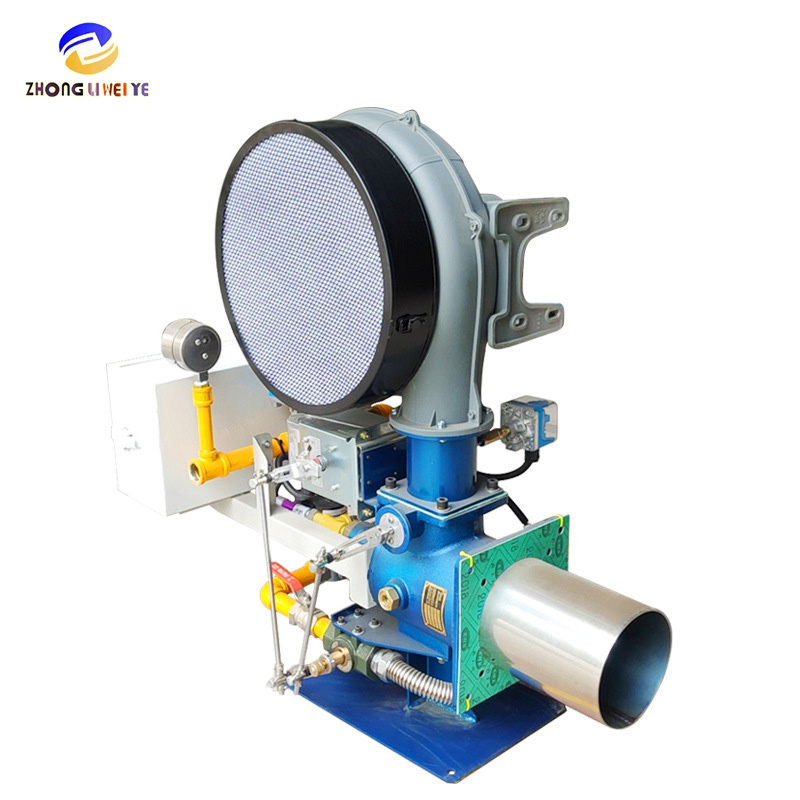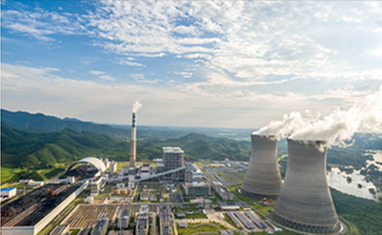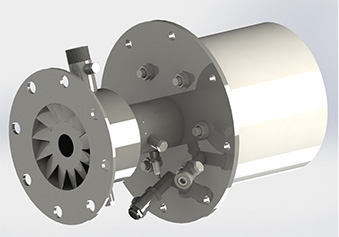Welcome to Shenzhen Zhongli Weiye Electromechanical Equipment Co., Ltd!
Hotline::

News
Check category
Contact Us
Shenzhen Zhongli Weiye Electromechanical Equipment Co., Ltd
Mobile Phone:15816882025
Fax:0755-28968949
Address: No. 2268, Longgang section, Longgang Avenue, Longgang District, Shenzhen
19
2023-08
Application of Zhengying BJ Burner

06
2021-07
Introduction of low nitrogen burner
Low nitrogen burners and low nitrogen oxide burners refer to burners with low NOx emissions during fuel combustion. Low NOx burners can reduce NOx emissions during combustion. The nitrogen oxides produced in the combustion process are mainly no and NO2, which are commonly referred to as nitrogen oxides NOx.

03
2021-07
Possible measures to suppress NOx generation
1. Reduce the peak temperature of the boiler and the amount of pulverized coal in the combustion area.
2. Reduce the oxygen concentration (i.e. reduce the excess air coefficient) and block part of the secondary air duct.

02
2021-07
Principle of low nitrogen burner
The precombustion chamber of low nitrogen burner is a high-efficiency, low nitrogen staged combustion technology developed and researched in China in the past 10 years. The precombustion chamber is generally composed of primary air (or secondary air) and fuel injection system. The fuel and primary air are rapidly mixed to form a fuel rich mixture in the primary combustion area of the precombustion chamber. Due to lack of oxygen, only part of the fuel is burned, and the fuel releases volatiles in the oxygen poor and low flame temperature primary flame area, Thereby reducing NOx generation. Any low nitrogen combustion technology is essentially a technology that controls the combustion process. According to the 20-year experience in the use of low nitrogen burners in Europe and the United States, it is not enough to replace or transform the burners for industrial boilers to achieve truly sustainable and reliable low nitrogen combustion. It is also necessary to upgrade the combustion control device, such as adding a "timely control" combustion control device. The mixing promoting burner is designed according to this principle.

30
2021-06
The difference between low nitrogen burner and ordinary burner
Low-nitrogen burner is a general term for a burner that optimizes overall emission and combustion technology on the basis of the original boiler to reduce NO3 and nitrogen oxides. Low-nitrogen burners, by adjusting the combustion air and combustion head, can obtain the best combustion parameters. According to the operation and operation mode, it is divided into: one-stage, two-stage, progressive two-stage and progressive two-stage with proportional regulator, etc. (the latter implements proportional adjustment operation)
Low NOx burners are roughly divided into the following categories: stage burners, self-recirculation burners, rich-lean burners, split flame burners, hybrid-promoting burners, low NOx pre-chamber burners, etc. Each has its own advantages.
What is the difference between a low nitrogen burner and an ordinary burner?
1. Save costs and reduce expenses
2. Time saving: The newly purchased boiler has a long cycle and a long waiting time, which affects production, while the low-nitrogen transformation requires only a short period of construction to complete the transformation.
3. The subjective factor of low-nitrogen transformation is caused by the general environment. In the long run, it is a good living environment for future generations. At present, it is a requirement of documents. Therefore, it is necessary to pass this level in order to produce.
Shenzhen Zhongli Weiye Electromechanical Equipment Co., Ltd., on the basis of absorbing domestic and foreign advanced technology and craftsmanship, has accumulated many years of wisdom and experience in burners, and the accuracy, stability and reliability of products are in an important position in China. Our company produces Zhongli Weiye brand burner has been gradually upgraded from the first generation product to the current third generation product, and is still developing higher-end products. It is an advanced ultra-low nitrogen burner enterprise in China. With advanced technology, excellent quality and perfect service, our company's products rank in the forefront of the domestic super-burner industry, and have become a well-known domestic brand, with products all over the country, we actively advocate; market-oriented, scientific research The leader, with innovation as a means, actively explores domestic and foreign markets.

28
2021-06
Types of combustion of low nitrogen burners
1. Stage burner
The stage burner designed according to the principle of staged combustion makes the fuel and air mix and burn in stages. Since the combustion deviates from the theoretical equivalence ratio, it can reduce the generation of nitrogen.
2. Self-recirculating burner
One is to use the pressure head of the combustion air to inhale part of the combustion flue gas, enter the burner, and mix and burn with the air. Due to flue gas recirculation, the heat capacity of the combustion flue gas is large, the combustion temperature is reduced, and the NOx is reduced. Another type of self-recirculating burner is to directly recirculate part of the flue gas in the burner and add it to the combustion process. This kind of burner has the dual effects of suppressing nitrogen oxides and saving energy.
3. Concentrated burner
The principle is to make part of the fuel burn too rich and the other part burn too lean, but the overall air volume remains unchanged. Since both parts are burned off-stoichiometric, the NOx is very low. This type of combustion is also known as off-stoichiometric or non-stoichiometric combustion.
4. Split flame burner
The principle is to divide a flame into several small flames. Due to the large heat dissipation area of the small flames and the lower flame temperature, the "thermal reaction NO" decreases. In addition, the small flame shortens the residence time of oxygen, nitrogen and other gases in the flame, and has obvious inhibitory effects on "thermal reaction NO" and "fuel NO".
5. Mixing-promoting burner
The residence time of the flue gas in the high temperature area is one of the main factors affecting the amount of NOx generation. Improving the mixing of combustion and air can reduce the thickness of the flame surface. Under the condition of constant combustion load, the flue gas is at high temperature on the flame surface. The residence time in the zone is shortened, thereby reducing the amount of NOx generated. Mixing-promoting burners are designed according to this principle.
6. Low nitrogen pre-combustion chamber burner
The pre-combustion chamber is a high-efficiency, low-nitrogen staged combustion technology developed and researched in my country in the past 10 years. The pre-combustion chamber is generally composed of primary air (or secondary air) and a fuel injection system, and the fuel and primary air are rapidly mixed.
A fuel-rich mixture is formed in the primary combustion zone in the pre-combustion chamber. Due to lack of oxygen, only part of the fuel is burned, and the fuel precipitates volatiles in the primary flame zone with lean oxygen and lower flame temperature, thus reducing the generation of NOx.
The essence of any low-nitrogen combustion technology is to control the combustion process. According to 20 years of experience in the development and use of low-nitrogen burners, to achieve truly sustainable and reliable low-nitrogen combustion in industrial boilers, it is not enough to just replace or modify the burner, and it is also necessary to upgrade the combustion control device.

26
2021-06
Gas Burner
According to its working principle, a burner can be defined as a device that converts substances into heat through the chemical reaction of combustion - that is, air and fuel are mixed in an appropriate proportion through a premixing device to make it fully burned. The burner is a thermal energy device that feeds fuel and air into the furnace according to the required concentration, velocity, turbulence and mixing mode, and enables the fuel to stably ignite and burn in the furnace. The fuel is mainly fuel oil and gas. Generally used in small and medium oil or gas boilers. Gas burners are divided into natural gas burners, city gas burners, etc.
According to the combustion control mode of the burner, it is divided into: single-stage fire burner, double-stage fire burner, proportional adjustment burner.
According to the fuel atomization method, it is divided into: mechanical atomizing burner, medium atomizing burner;
According to the structure, it is divided into: integral burner and split burner. Among them, the split burner is mainly used in industrial production, and its main feature is that the combustion system, air supply system, control system, etc. are all disassembled and installed. This kind of machine is mainly suitable for large equipment or special working environments such as high temperature.
Relatively speaking, commercial burners are relatively inexpensive due to mass production and low specialization requirements in the market supply chain, while split burners have relatively high specialization requirements, and Most require a professional installation team, and the market sales price is relatively much higher than the same period last year.
The gas burner construction consists of the following 5 systems:
1. Air supply system The function of the air supply system is to send air with a certain wind speed and air volume into the combustion chamber. Its main components are: shell, fan motor, fan impeller, air gun fire pipe, damper controller, damper baffle , Cam adjustment mechanism, diffuser plate.
2. Ignition system
The function of the ignition system is to ignite the mixture of air and fuel, and its main components are: ignition transformer, ignition electrode, electric fire high-voltage cable.
3. Monitoring system
The function of the monitoring system is to ensure the safe and stable operation of the burner, and its main components include a flame monitor, a pressure monitor, and a temperature monitor.
4. Fuel system
The function of the fuel system is to ensure that the burner burns the required fuel. The fuel system of the oil burner mainly includes: oil pipe and joint, oil pump, solenoid valve, nozzle, heavy oil preheater. Gas burners mainly include filters, pressure regulators, solenoid valve groups, ignition solenoid valve groups, and fuel butterfly valves.
5. Electronic control system
The electronic control system is the command center and contact center of the above systems. The main control element is the program controller. Different burners are equipped with different program controllers. The common program controllers are: LFL series, LAL series, LOA series, LGB series , the main difference is that the time of each program step is different.
When the combustible gas (city gas, natural gas, liquefied petroleum gas) is controlled by the microcomputer control system to enter the combustion head of the burner according to the program, the primary air is mixed with the combustible gas, ignited and burned, and the secondary air supports combustion to achieve full combustion. The combustion state is detected and controlled by the flame automatic tracking system. When the combustion fails (oxygen deficiency in the combustion chamber, underpressure of combustible gas, cut-off of combustible gas, insufficient gas volume, etc.), the control system issues an instruction, and the solenoid valve of the gas supply system is quickly closed. , cut off the gas power supply, the burner will automatically shut down after purging, indicating a fault. 1) High thermal efficiency: It can adapt to pressure fluctuations and adjust the primary air distribution by itself (that is, if the gas pressure is large, the primary air is more inhaled; the gas pressure is small, the primary air is inhaled), the combustion is sufficient, and the thermal efficiency is high;
(2) High safety: The burner is equipped with a small fire. When the boiler starts, light a small fire first. When the small fire burns normally and stably, the automatic control system opens the main gas valve, and the fuel can enter the boiler for normal combustion without deflagration;
( 3 ) Strong fuel adaptability: This burner can be used for natural gas, liquefied petroleum gas, coal gas, liquefied petroleum gas mixture and other types of gas only by replacing a few parts
Because the main fuels of gas burners are natural gas, liquefied petroleum gas, city gas and other combustible gases, these fuels are flammable and explosive
25
2021-06
Low nitrogen combustion technology
Determining the formation of NOx is the temperature of the combustion zone and the amount of excess air. Therefore, the low NOx combustion technology is to prevent the formation of NOx and reduce its emission by controlling the temperature and air volume in the combustion area.
Previous page
1
2
…
16
Next page
Contact Us
mobile phone:15816882025
Fax:0755-28968949
E-mail:2843385065@qq.com
Web:www.szburners.com
Address: No. 2268, Longgang section, Longgang Avenue, Longgang District, Shenzhen

Website QR code
copyright © 2022 Shenzhen Zhongli Weiye Electromechanical Equipment Co., Ltd SEO Tag 粤ICP备20006542号 Powered by www.300.cn

 中文简体
中文简体
